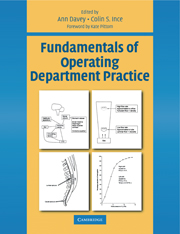Book contents
- Frontmatter
- Contents
- Contributors
- Preface
- Foreword
- Acknowledgements
- Introduction
- Chapter 1 The operating department practitioner, the patient and the law
- Chapter 2 Aspects of health and safety in the operating department
- Chapter 3 The caring practitioner
- Chapter 4 Strategies for infection control in the operating department
- Chapter 5 Sterilization, decontamination and the surgical field
- Chapter 6 The fundamentals of cardiovascular physiology
- Chapter 7 Fundamentals of respiratory physiology
- Chapter 8 Scientific principles in relation to the anaesthetic machine
- Chapter 9 Fundamentals of artificial ventilation of the lung
- Chapter 10 Scientific principles in relation to monitoring equipment
- Chapter 11 Scientific principles in relation to endoscopic, laser and radiological equipment
- Chapter 12 Pharmacological principles of drug administration
- Chapter 13 The pharmacology of drugs used in general anaesthesia
- Chapter 14 The local anaesthetic drugs - does the ideal agent exist?
- Chapter 15 The safe positioning of patients for surgery
- Chapter 16 Principles involved in the management and use of equipment
- Chapter 17 Understanding suture materials
- Chapter 18 Fundamentals ofpaediatric surgery and anaesthesia
- Chapter 19 Fundamentals of hyperthermia and hypothermia
- Chapter 20 Fundamentals of fluid and electrolyte balance during surgery
- Chapter 21 The physiology of blood and its administration
- Chapter 22 Fundamentals of pain relief
- Chapter 23 Fundamentals of dressings and drains in relation to wound healing
- Chapter 24 The recovery of patients from anaesthesia and surgery
- Chapter 25 Fundamentals of emergency and obstetric anaesthesia
- Chapter 26 Identification and management of anaesthetic emergencies
- Chapter 27 The fundamentals of emergency resuscitation
- Appendixes
- Index
Chapter 9 - Fundamentals of artificial ventilation of the lung
Published online by Cambridge University Press: 05 October 2015
- Frontmatter
- Contents
- Contributors
- Preface
- Foreword
- Acknowledgements
- Introduction
- Chapter 1 The operating department practitioner, the patient and the law
- Chapter 2 Aspects of health and safety in the operating department
- Chapter 3 The caring practitioner
- Chapter 4 Strategies for infection control in the operating department
- Chapter 5 Sterilization, decontamination and the surgical field
- Chapter 6 The fundamentals of cardiovascular physiology
- Chapter 7 Fundamentals of respiratory physiology
- Chapter 8 Scientific principles in relation to the anaesthetic machine
- Chapter 9 Fundamentals of artificial ventilation of the lung
- Chapter 10 Scientific principles in relation to monitoring equipment
- Chapter 11 Scientific principles in relation to endoscopic, laser and radiological equipment
- Chapter 12 Pharmacological principles of drug administration
- Chapter 13 The pharmacology of drugs used in general anaesthesia
- Chapter 14 The local anaesthetic drugs - does the ideal agent exist?
- Chapter 15 The safe positioning of patients for surgery
- Chapter 16 Principles involved in the management and use of equipment
- Chapter 17 Understanding suture materials
- Chapter 18 Fundamentals ofpaediatric surgery and anaesthesia
- Chapter 19 Fundamentals of hyperthermia and hypothermia
- Chapter 20 Fundamentals of fluid and electrolyte balance during surgery
- Chapter 21 The physiology of blood and its administration
- Chapter 22 Fundamentals of pain relief
- Chapter 23 Fundamentals of dressings and drains in relation to wound healing
- Chapter 24 The recovery of patients from anaesthesia and surgery
- Chapter 25 Fundamentals of emergency and obstetric anaesthesia
- Chapter 26 Identification and management of anaesthetic emergencies
- Chapter 27 The fundamentals of emergency resuscitation
- Appendixes
- Index
Summary
HISTORY OF ARTIFICIAL VENTILATION
Artificial ventilation of the lungs can be performed without any equipment at all. Early descriptions of resuscitation include the use of expired air ventilation, which was used in victims of drowning. This involved manipulation of the arms to expand the thorax and draw air into the lungs but has been superseded by ‘the kiss of life’ with ventilation using expired air. However, as long ago as 1788, Kite of Gravesend described oral and nasal intubation for the resuscitation of the apparently drowned patient. In 1871 Trendelenberg anaesthetized a patient through a tracheostomy wound and occluded the trachea with an inflatable cuff but it was Langton Hewer who, in 1939, reintroduced the concept of the pilot tube.
In 1934 Guedel and Treweek introduced artificial ventilation of the lungs into anaesthesia and in 1936 Waters first used the term ‘controlled respiration’. Guedel and Treweek controlled breathing using deep ether anaesthesia to raise the threshold of the respiratory centre. Controlled ventilation was greatly facilitated by the development of muscle relaxants. Much of this work in the UK was done by Gray and Rees in Liverpool and resulted in the so-called ‘Liverpool Technique’ of anaesthesia.
During the 1950s in Sweden there was a major epidemic of poliomyelitis. Medical students were paid to help with the ventilation of these patients and this event helped to speed up the development of mechanical ventilators.
USES OF ARTIFICIAL VENTILATION
Artificial ventilation of the lungs is used on a daily basis across the world, predominantly as part of an anaesthetic technique associated with muscular paralysis. Assisted ventilation is mainly used within intensive care units as a means of life support whilst recovery from disease or injury is awaited. Cardiopulmonary resuscitation also relies upon artificial ventilation until spontaneous respiration is restored. An infrequent but important use of artificial lung ventilation is for patients who have problems from which they are unlikely to recover and for whom artificial ventilation is a lifelong necessity.
Information
- Type
- Chapter
- Information
- Fundamentals of Operating Department Practice , pp. 97 - 108Publisher: Cambridge University PressPrint publication year: 1999
